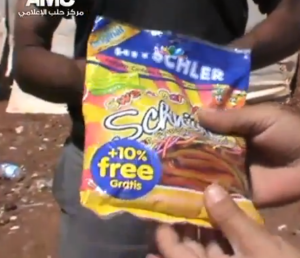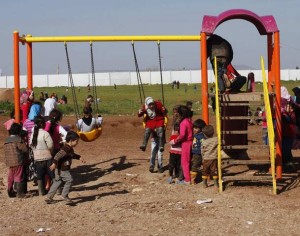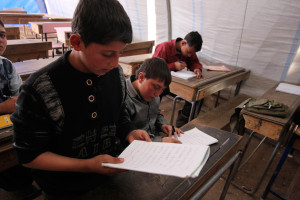“Where is the international community? What are you waiting for? At least impose a no-fly zone or an embargo,” a female Syrian refugee demanded of US Secretary of State John Kerry last week, when he visited the Zaatari refugee camp in north Jordan.
Kerry’s response — “We are trying to help in various ways, including helping Syrian opposition fighters have weapons. We are doing new things. There is consideration of buffer zones and other things, but it is not as simple as it sounds” — is unlikely to have impressed the 115,000 Syrians living in Zaatari.
And while the debate continues in the US and Europe over the arming of Syrian insurgents or imposition of a no-fly zone, 17,000 internally displaced persons — including 5,000 children — endure horrific conditions in the Bab al-Salam refugee camp in Azaz on the Turkish border, crammed together in 1,500 tents.
Bab Al-Salam and its surrounding area is under insurgent control. Those living there are waiting to be allowed to seek asylum in Turkey, which since August 2012 has refused them entry.
This video, posted on Thursday, shows footage of the camp — including some of its youngest inhabitants — with comments from one man about the terrible living conditions.
Food is scarce in the camp. Although this small child appears happy to receive a packet of candy — Hitschler Sweet Party Laces somehow obtained from Turkey, possibly in an aid shipment — it is hardly nutritious.
As well as poor nutrition, both children and adults in the camp are suffering from health issues — and not just the gastroenteritis and water-borne diseases that one would expect in such conditions. Residents of Bab Al Salam have also reported a disease named cutaneous leishmaniasis. Transmitted by sandflies, the disease causes painful skin ulcers — sometimes as many as 200 — on the face, arms and legs, which can result in disability and scarring.
Residents of Bab Al Salam are also at risk from attacks by regime forces. There have also been several reports, including eyewitness accounts, of an airstrike on June 25.
Catholic organization Fides citing volunteers who provide humanitarian aid, said seven people were seriously injured in the attack — among them a child.
Fides quoted a Time4Life volunteer, “Our contacts in the camp fear that this is the beginning of an escalation of raid scares implemented by government armed forces also to force refugees to flee the land, in view of the impending offensive of pro-Assad forces to regain full control of Aleppo.”.
A Syrian activist who visited the camp on June 26, speaking to Human Rights Watch, said that the seven injured Syrians were allowed into Turkey for treatment but the Turkish authorities kept the nearby border crossing closed.
Ankara says that it is stretched to capacity — a report by The Guardian on Thursday noted that “Turkey’s capacity for hosting more Syrian refugees is stretching thin, and that international assistance will be vital to cope with a steady influx of those fleeing an increasingly bloody civil war across the border”.
The Guardian cite a clinic manager from the Kilis refugee camp on the Turkish side of the border:
“Turkey has been left alone with this crisis,” said Servet Keskuk, the manager of the clinic in the Kilis refugee camp. “On average, we have three births every day in our facility alone. More Syrians are likely to come. We try to do our best to handle this, but other countries should do more to help.”
The Guardian also notes that Turkey has spent 1.04 billion Turkish lira ($545 million), of which foreign aid has contributed only 2 million.
Turkey is also concerned about rising tensions and instability in its southeast provinces, particularly following May’s double car bombing in Reyhanli, which killed 51 people.
Those concerns and camps stretched to capacity prompted statements by Prime Minister Recep Tayyip Erdogan of Ankara’s eagerness to be in a no-fly zone, but that opening has closed amid US reluctance, protests within Turkey, and the emergence of fighting between insurgents and Kurdish militia in northern Syria. Nor has there been any proposal on how to deal with the growing numbers of Syrians who are homeless on either side of the border.
So for the 17,000 in Bab Al Salam — and the millions living in camps in Turkey, Lebanon, Jordan, Iraq, and Egypt or displaced within Syria — there is little more than the words that the situation “is not as simple as it sounds”.
***
More images and footage from Bab Al Salam:
The Turkish border earlier this month, seen from Bab Al Salam:
Children play in the camp:
Children studying in Bab Al-Salam in March (photo by Reuters):
Time Magazine’s story from January provides a glimpse of the terrible conditions in Bab Al Salam in the winter.





